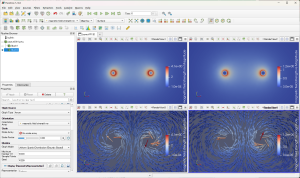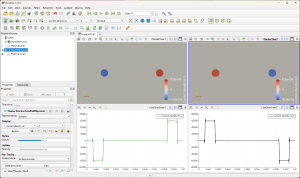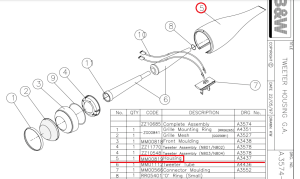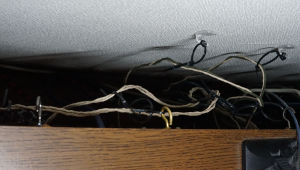スピーカーケーブル(75Ω同軸ケーブル)の磁場解析(1) ― 2022年10月24日 21:03
片端に電圧を与え、反対側を接地した条件で解析しました。
今回は、磁界の解析結果です。
虚部が4倍近く大きく、このケーブルは20kHzで主にインダクタンス成分となります。
ちなみに、インダクタンスの測定値は
以前説明したフラットケーブル:0.1μH/75cm
75Ω同軸ケーブル(2本往復、S5CFB):1.1μH/m
ベクトルが虚部と実部で逆向きになっているので、値の小さい実部のデータはちょっと怪しいです。
実部(re)の値は信用しないでね。
電流分布は、明日アップロード予定です。
A magnetic field analysis of an SP cable made of 75Ω coaxial cable was performed using the Finnish open CAE software "ElmerFEM".
The analysis was performed under the condition that voltage was given at one end and the other end was grounded.
This time, the result of the magnetic field analysis is shown.
The imaginary part is almost 4 times larger, and this cable is mainly an inductance component at 20 kHz.
Incidentally, the measured values of inductance are
Flat cable described previously: 0.1μH/75cm
75Ω coaxial cable (2-way, S5CFB): 1.1μH/m
Since the vectors are in opposite directions for the imaginary and real parts, the data for the real part, which has a smaller value, is a bit suspect.
Do not trust the value of the real part (re).
The current distribution will be uploaded tomorrow.
スピーカーケーブル(75Ω同軸ケーブル)の磁場解析(2) ― 2022年10月25日 15:48
20kHzとインダクタンスや表皮効果の影響をほとんど受けない2Hzの条件で電流密度を計算しました。
電流密度は、主成分のみ値を抽出しました。
計算サイトの値とほぼ一致しました。
導体間隔が広い場合は、表皮効果・近接効果と比べてインダクタンスの影響が大きいことが判りました。
フリーソフト(ElmerFEM)で、静磁場、周波数応答解析ができてうれしいです。
なお、LTspiceの過渡解析でインダクタンスの影響が判ったように、正確には過渡解析を行う必要があるかもしれません。
商用ソフトでは過渡解析が可能なソフトがあります(URLリンクの運動過渡解析ソルバ)。
解析を依頼すると、昔の経験から20~50万円くらいになると思います。
オーディオケーブルの会社でないとちょっと躊躇します。
https://www.ad-tech.co.jp/products/magnet/function
電流密度
20kHzのim成分:15000 [A/m^2]
2Hzのre成分:59590 [A/m^2]
20kHzでの電流値は2Hzでの1/3.97
計算サイトでの値(URLの1.往復円柱導体、20kHz)
Zac/Rdc = 1.03391 + j*3.69962
これより、 |Zac| / Rdc = 3.84 20kHzでは電流が1/3.84になる計算
http://www.mogami.com/cad/proximity-01.html
This is the current density section of yesterday's 75-ohm coaxial cable (going back and forth with two cables, S5CFB).
The current density was calculated at 20 kHz and at 2 Hz, where inductance and skin effects have little effect.
For the current density, only the principal component values were extracted.
The values were in close agreement with the values at the calculation site.
It was found that when the conductor spacing is wide, the effect of inductance is larger than that of skin effect and proximity effect.
I am glad to be able to perform static magnetic field and frequency response analysis with free software (ElmerFEM).
As the effect of inductance was found by the transient analysis of LTspice, it may be necessary to perform a transient analysis precisely.
There is commercial software that can do transient analysis (motion transient analysis solver in the URL link).
If you ask for the analysis, it will cost about 200,000 to 500,000 yen based on my old experience.
I would be a little hesitant unless you are an audio cable company.
https://www.ad-tech.co.jp/products/magnet/function
Current density
im component at 20kHz: 15000 [A/m^2].
re component at 2Hz: 59590 [A/m^2].
Current value at 20 kHz is 1/3.97 at 2 Hz
Value at the calculation site (1.0 in URL. Reciprocating cylindrical conductor, 20 kHz)
Zac/Rdc = 1.03391 + j*3.69962
From this calculation, |Zac| / Rdc = 3.84 At 20kHz, the current is 1/3.84
http://www.mogami.com/cad/proximity-01.html
スピーカーの修理部品が待ち遠しい ― 2022年10月26日 15:55
テスターにより抵抗を測定すると、高抵抗になるので断線しているようです。
図面を見て、現物(図面の④)を外すと取り替えられそうだったので今月初めにeBayで発注しました。
今月末頃に米国から届く予定です。
ヘッドホンとパソコンのスピーカーで聴く機会が増えました。
届けば良い音で聴きたいので、気が早いですが接続ケーブルをエナメル線+綿ワックスコードに変えました。
ヘッドホンにより聴くと、ベースやコントラバスが聞き取りやすくなりました。左右の位相や高音の伸びも良くなりました。
古い米国製DAコンバータの出力インピーダンスが2.4kΩ(仕様は2.5kΩ以下)の音が大きく改善されました。シールドなしかシールド付きなら低静電容量のものを50cm以下でないと、電圧波形がなまり実力が発揮できない製品のように思います。
SACDプレイヤーの出力インピーダンスは100Ω(測定値)ですが、接続ケーブルを自作ケーブルに交換することで、DAコンバータ程ではないが改善されました。
プリアンプの出力インピーダンスも100Ω(測定値および仕様値)なので、自作ケーブルに交換しました。
片側のツィーターが壊れたときは、主音量の成分により妥協できる音源もあるし、あまり問題ない音源があります。
古い「Clara Haskil」のモノラル録音を聴くと、ずっと良くなったと感じました。
Can't wait for speaker repair parts.
The tweeter on one side of my B&W N804 speaker, which I bought with great enthusiasm 20 years ago, has broken.
Measuring the resistance by a tester, it seems to be disconnected because of high resistance.
After looking at the drawings, it looked like I could replace it by removing the actual one (4) from the drawing, so I placed an order on eBay at the beginning of this month.
It will arrive from the U.S. around the end of this month.
I have more chances to listen to it with headphones and computer speakers.
I want to listen to the sound better when it arrives, so I changed the connecting cable to enamel wire + cotton wax cord, although it is too early to say.
When I listen with headphones, I can hear bass and contrabass more easily. The phase between left and right and the extension of treble have also improved.
The sound of an old U.S. DA converter with an output impedance of 2.4kΩ (the specification is 2.5kΩ or less) was greatly improved. I think that the product cannot show its full potential because the voltage waveform becomes sluggish unless it is unshielded or, if shielded, a low capacitance one is used at a distance of 50 cm or less.
The output impedance of the SACD player is 100Ω (measured value), but by replacing the connection cable with a self-made cable, the sound was improved, though not as much as the DA converter.
The output impedance of the preamplifier is also 100 ohms (measured and specified value), so I replaced it with my own cable.
When one side of the tweeter is broken, some sound sources can be compromised depending on the main volume component, while others are not so problematic.
Listening to an old "Clara Haskil" mono recording, I found it much better.
オーディオでノンシールドケーブルを使うテクニック ― 2022年10月26日 17:02
私は、以下の対策を実施しています。
気を遣う必要がありますが、以下の対策を行ってからノイズを拾ったことはありません。
工夫すれば、ノンシールドのケーブルにより配線できます。
優先度1
ラックの裏側と壁にフックを付け、結束バンドにより空中配線の位置がある程度維持できるようにしています。
信号ケーブルを電源ラインに近づけない
信号ケーブルの左右を近づけない
異なる信号ケーブルを近づけない
プリアンプへの接続は、名前を気にせずクロスしない位置に接続する
(CDをAUX2、DAコンバータをTunerに接続しました)
Phonoはだめですよ
優先度2
プリアンプの入力が選択されていない場合、hot-cold間が高抵抗になるので、 万が一の電源ラインとの接近リスクを考えて、ケーブル終端側のhot-cold間に抵抗を接続しています。
DAコンバータ:出力のhot-cold間に5kΩが入っていたので不要
SACDプレイヤー:出力が出ていない場合はhot-cold間が短絡されていた(信号ラインにスイッチを付けることによる音質低下は問題ないのか、音質よりもプレイヤーの保護優先の設計)
プレイヤーの出力特性が10kΩ時になっていたので、hot-cold間に8.2kΩを接続
パワーアンプの入力:hot-cold間に12kΩを接続
Techniques for using non-shielded cables in audio
Using unshielded cables can cause noise from the AC power line and crosstalk with other signal lines, mainly due to electrostatic induction if poorly placed.
I have implemented the following countermeasures.
You need to be careful, but I have not picked up any noise after implementing the following countermeasures.
With ingenuity, wiring can be done by non-shielded cables.
Priority 1
Hooks are attached to the back of the rack and to the wall so that the aerial wiring can be maintained in some position by means of cable ties.
Keep signal cables away from power lines
Keep signal cables away from left and right sides
Keep different signal cables away from each other
Connect to the preamplifier in a non-crossing position without regard to name
(I connected CD to AUX2 and DA converter to Tuner)
Phono is not allowed.
Priority 2
If the input of the preamplifier is not selected, the hot-cold connection will have a high resistance, so I connect a resistor between hot and cold on the cable termination side, considering the risk of proximity to the power line in case it is close to the power supply line.
DA converter: 5kΩ was inserted between hot and cold at the output, so it is unnecessary.
SACD player: hot-cold was shorted between hot-cold when no output was present (Is there any problem with sound quality degradation due to a switch on the signal line?) This design prioritizes player protection over sound quality.
Since the output characteristic of the player was at 10kΩ, 8.2kΩ was connected between hot-cold
Power amplifier input: 12kΩ connected between hot and cold
Ubuntu(WSL)アプリとWindowsアプリを区別できますか ― 2022年10月27日 16:49
ちなみにKateはWindowsアプリです(起動に少し時間がかかるのでKateを気に入っている方以外は、不要だと思います)
私はNotepad++を使用していて、Kateは時々使う程度です
Windows版のダウンロード先(検索で見つけるのは少し難しい)
https://binary-factory.kde.org/view/Windows%2064-bit/
Release版が良い思います
WSLは、Linux端末コマンドから個別のWindowが起動するので、私には使いやすいです
回答は、Twitterの代替テキストに記載しています
Can you distinguish between Ubuntu (WSL) apps and Windows apps?
I've tried launching the CAE-related apps I use from WSL and Windows.
By the way, Kate is a Windows app (unless you like Kate as it takes a bit of time to start up, which I don't think is necessary)
I use Notepad++ and use Kate only occasionally.
Where to download the Windows version (a little hard to find by search)
https://binary-factory.kde.org/view/Windows%2064-bit/
I think the Release version is better.
WSL is easier for me to use because it launches a separate Window from the Linux terminal command!
Answers are in the alternative text on Twitter





最近のコメント